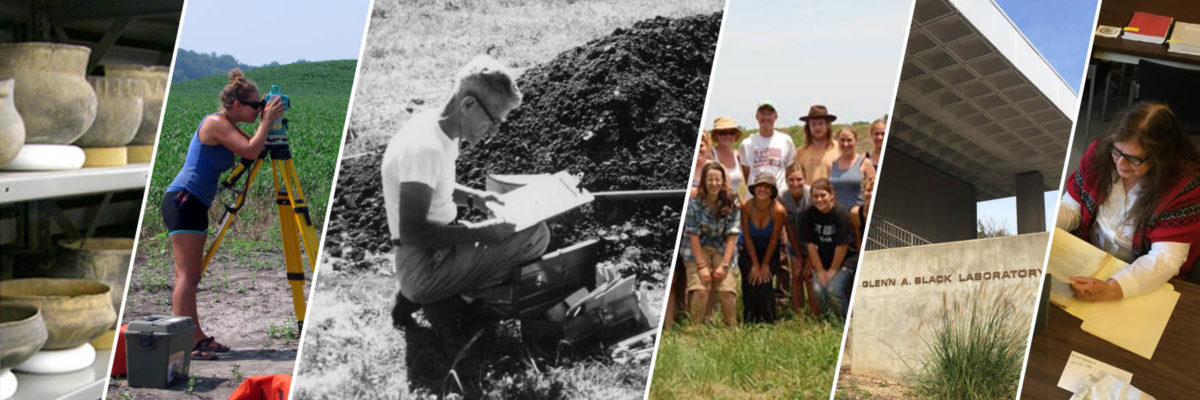November 27, 2018
Planning an exhibit takes a lot of time and energy on the part of all involved. During the process of putting up our new exhibit, “Animal~Spirit~Human,” we created a to-do list to make sure we checked all the boxes and put up an exhibit we were proud of.
Here’s a condensed version of that list:
1. Generate Theme
Our exhibit followed this semester’s Themester theme of animal-human relationships. “Animal~Spirit~Human” follows that theme by investigating the role of animals in sustaining and inspiring past and present Native people of the Eastern Woodlands. Once we had our theme in mind, we were able to create a uniform aesthetic to make sure all of the cases matched. This entailed picking fonts and a color scheme, and determining what size each of the different labels should be, to make sure all exhibit goers could easily read them.
2. Select Artifacts/Prepare Condition Reports
With that theme in mind, we were able to get an idea of what artifacts to include. Each case plays a different role in telling the story of animal-human relationships. The cases on the north wall of the gallery hall serve as an introduction to the exhibit. The east wall examines a worldview in terms of different spheres, such as air and water. The south wall compares pre- and post-European contact animal populations. And the west wall is dedicated to examining animal-human relations at Angel Mounds.

This means each wall’s theme determines the contents of its cases, allowing us to get an idea of what artifacts would best explain and exemplify the theme. Once we selected the artifacts, we photographed them and wrote condition reports. These detail the current condition of the artifacts by noting breakage, cracks, and repairs. They allow us to keep track of where the artifact is and why it was removed from the collections. When we take the exhibit down, we’ll do another round of condition reports to see if anything changed.
3. Prepare Exhibit Cases

Putting in a new exhibit required us to take out the old, “Containing Knowledge: Ceramics at the GBL.” After doing the follow-up photos and condition reports, we returned the artifacts to our collections. Once we removed the old display blocks and the cases were empty, we spent several days cleaning and repainting them. This brightened the exhibit space and made the gallery look more inviting. Many artifacts are unable to stand on their own, so it was necessary to create mounts for them. We carved mounts out of foam and other materials on which to display them. The foam mounts were covered with a layer of fabric in between the material and the artifact, for both the safety of the artifact and to provide a contrasting background.
4. Research Collections and Write Text
Now it was time to write the text and select relevant images. Each case has four categories of labels: the Title (A), the Subheader (B), the Body Text (C), and the Artifact ID Labels (D). Defining the terminology of labels early on can prevent confusion later in the process, and make it easier to visualize the layout of the case before anything actually goes up. To write descriptions of the artifacts and their relevance to the theme, we utilize the collections and the resources in our library and archives.
5. Print Text/Images and Cut to Size

The next step was to print the text and images. This is a very time-consuming process, due to the size and amount of the various labels. We used the large printer over at our neighbor, the Mathers Museum, to print on Print-N-Stick paper, which has an adhesive backing that allows us to adjust the placement of the labels if necessary without damaging the paint in the cases.
6. Install Artifacts
During this step, timing is important since we can’t leave artifacts in unlocked cases. In most cases, the text was the first to go in. Then blocks or risers which elevated or raised the artifacts to needed heights were selected based on the artifact selection and case design. Artifacts and mounts, as well as barriers between artifacts and painted surfaces, were then added. Once the artifacts were in place, the case stays locked; so if text needed adjusting it was much easier to do that while the case was open and easily accessible.
7. Finishing Touches
Now it was time for last-minute touch-ups to labels and placement of any other artifacts. These included repairs to the overhead lights in the cases, and the erection of the folding wall in the middle of the hall, which displays shields from four tribes and descriptions of their histories, provided by the tribes themselves.
8. Sharing the Exhibit
Marketing the exhibit was an ongoing process throughout development and installation, but the main push came upon our opening in early October.
9. Events

Finally, to celebrate the opening of our exhibit, we threw events: on Thursday, Nov. 1, we had a talk by Dr. Cheryl Claassen, “On Deer, Shell Beads, and the Milky Way.” The following day, Friday, Nov. 2, we had a Themester panel, featuring Amanda Burtt, Dr. Claassen, Justin Downs, and Gary Morseau.
We learned a lot in the process of putting up this exhibit, and look forward to applying these new insights in the future. In the meantime, we hope you’ll come down to see the exhibit and celebrate Themester by attending some of the other great events on campus this semester!






